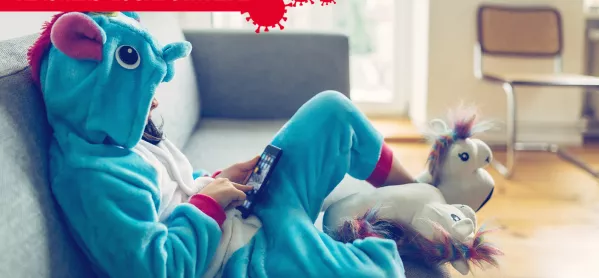Pyjamas and disco lights: Remote teachers reveal all

Who can blame teachers and students for finding the vagaries of remote learning challenging?
After all, as recent news demonstrates, it is all too easy to forget a cat filter on Zoom. Even the prime minister’s briefings have their fair amount of reporters who forget the all-important mute button.
Lockdown learning: Live lessons are teachers’ most popular remote option
‘Utterly draining’: The reality of teaching in lockdown
Exclusive: Exclusive: 63% teachers positive about remote education
That said, in a recent exclusive survey of more than 7,000 teachers by Tes, it was clear that online learning had its moments of light relief, too, although also its distractions - such as a pupil using disco lights during a lesson.
One state primary teacher said: “I have had to ask a pupil to turn off disco lights and, on other occasions, I have had to ask a pupil to stop dancing and walking around their home with their webcam showing different rooms during the lesson.”
Parents and hackers
In the responses:
- Over a quarter (25.3 per cent) reported that parents sometimes interrupt lessons or tell pupils the answers.
- Over a fifth (21.8 per cent) said pupils sometimes wear inappropriate clothing in lessons, such as pyjamas.
- In total, 43.9 per cent said pupils sometimes pretend they have technical difficulties to avoid taking part in online learning.
- A third (33.5 per cent) said parents had praised their online lessons, while 8.1 per cent said they had received criticism from parents.
- A small number, 4.5 per cent, said they had had lessons interrupted by hackers.
- A fifth (20.3 per cent) said their lessons were sometimes observed by senior leaders.
- Nearly half (45.7 per cent) said pupils often struggled to attend live lessons.
Some respondents raised concerns about being able to hear or see parents putting away shopping or pupils’ younger siblings in the background.
Teachers also commented that pupils were dressed inappropriately for lessons, for example showing up in pyjamas, although this laxity applied to staff in some cases, too.
A state primary teacher said: ”Personally I don’t care if they’’e wearing PJs...as long as they are engaging. Sometimes, I’m wearing PJs (on the bottom half!).”
Teachers also said they were concerned that pupils were distracted during online lessons, with one state secondary teacher commenting: “Some students attend the lessons but then don’t respond to any questions for 45 minutes, so they are probably no longer at their screen or have muted me. It is easy for students to hide.”
They added: “Some students spam the chat with random comments or pictures in order to distract or to push another student’s contribution upwards and out of sight.”
And there were also worries raised about the amount of parental help pupils could receive during lessons online.
A state primary teacher said: “Parents are often in the same room, ‘helping’ or guiding some children. Some children use these adults to help them, asking questions etc.”
They added that other siblings, cats or dogs entering lessons was an issue and “disruptive for everyone”, but added: “Parents, however, have been very supportive and appreciative of these lessons as they feel that the children are more engaged in their work, and it is much more of a social interaction with both teachers and pupils alike.”
‘A class of dots’
Teachers also commented that the need to keep cameras off and muted for safeguarding reasons could mean that they faced a “class of dots”, where they felt as though they were performing a monologue for an hour. Others said pupils logged into the lesson but then seemed to disappear in terms of their engagement.
And senior management “dropping in” to observe lessons online seemed to add to the pressure on teachers, with one respondent stating: “It is stressful that the headteacher and parents can see my lessons without announcing anything.”
However, more teachers reported being thanked by pupils and parents than receiving criticism.
And for some teachers, using online tools was a chance to check in on pupils’ wellbeing.
“Once a week, I do provide a live session for all pupils to come together and see their friends. We usually do something fun, like a quiz or cooking, as I would prefer to take the opportunity to focus on the wellbeing side of pupils during this time,” one teacher said.
You need a Tes subscription to read this article
Subscribe now to read this article and get other subscriber-only content:
- Unlimited access to all Tes magazine content
- Exclusive subscriber-only stories
- Award-winning email newsletters
Already a subscriber? Log in
You need a subscription to read this article
Subscribe now to read this article and get other subscriber-only content, including:
- Unlimited access to all Tes magazine content
- Exclusive subscriber-only stories
- Award-winning email newsletters